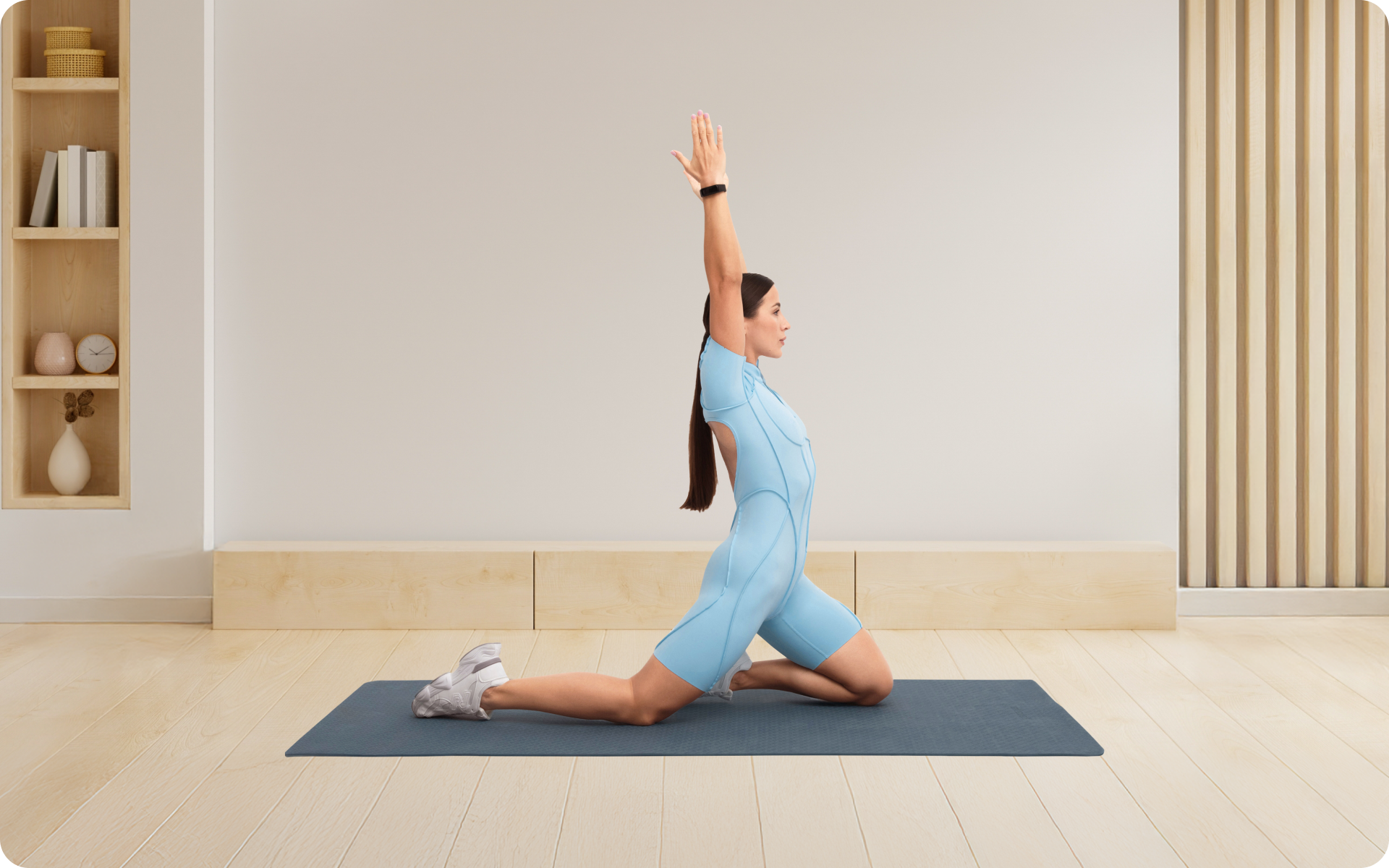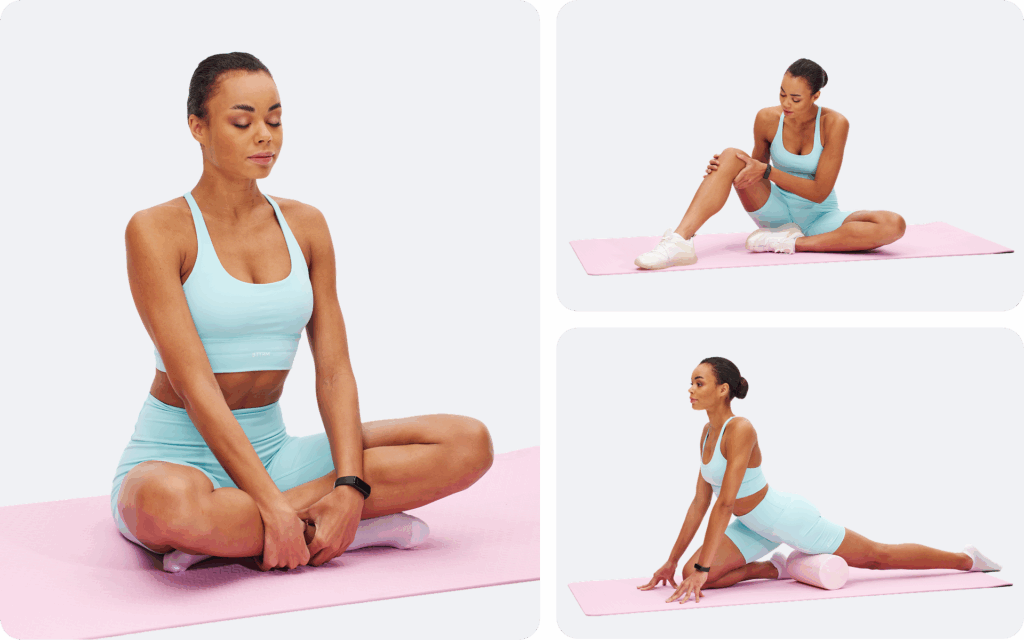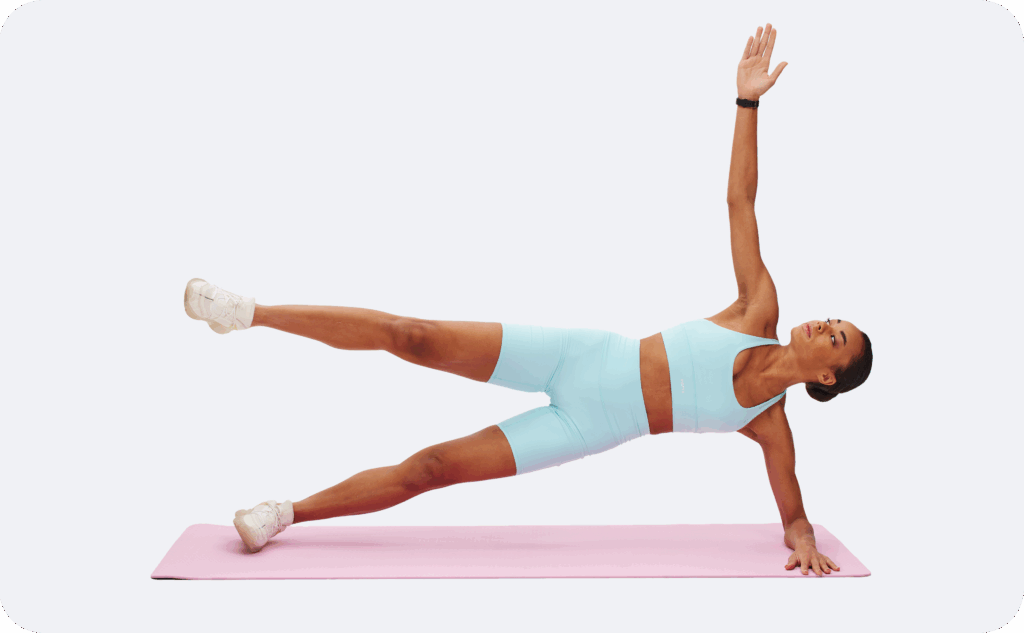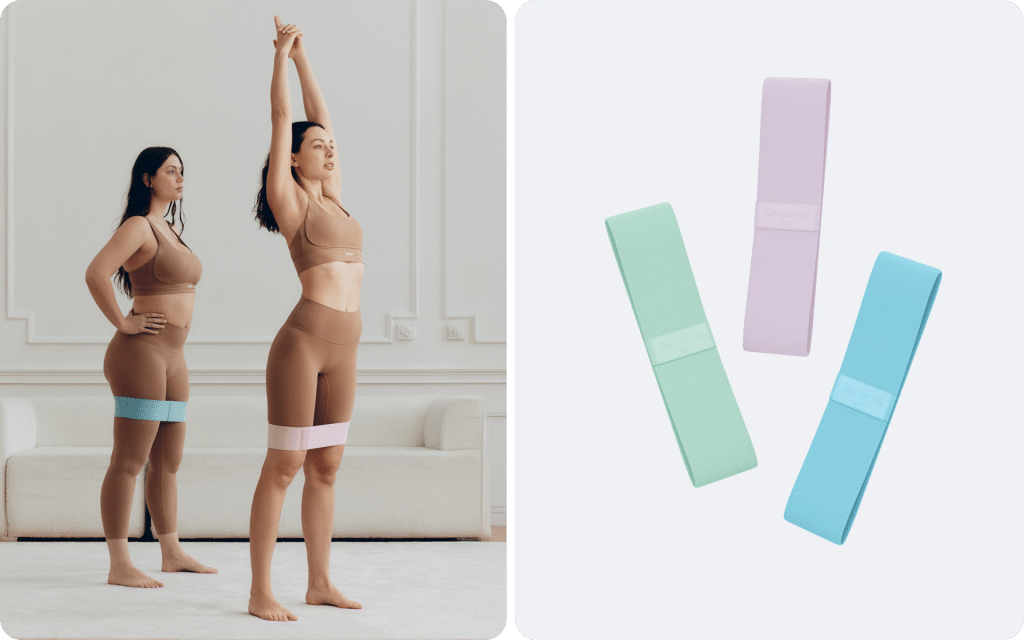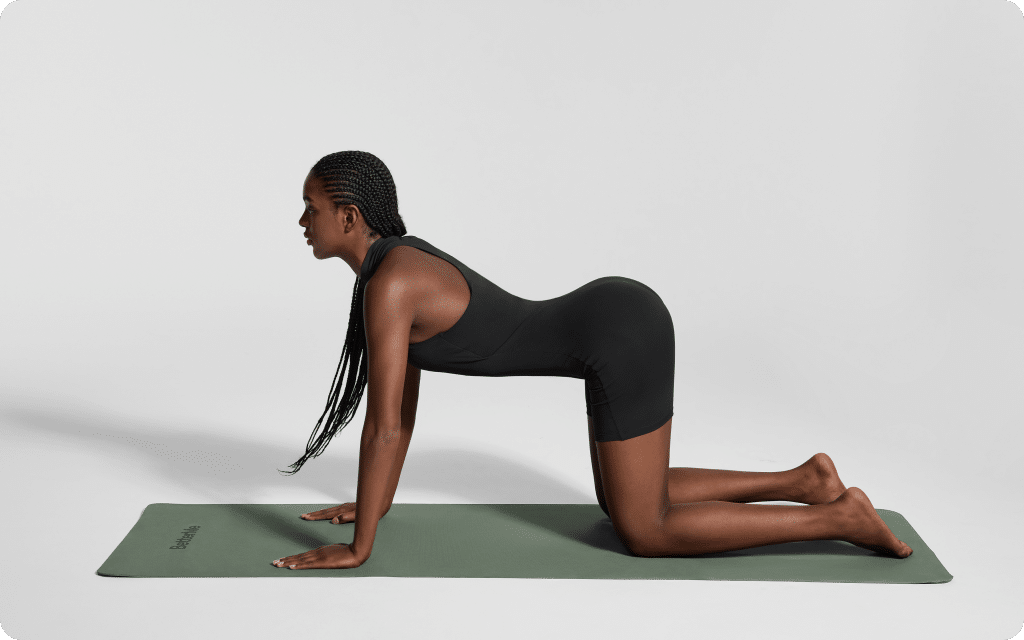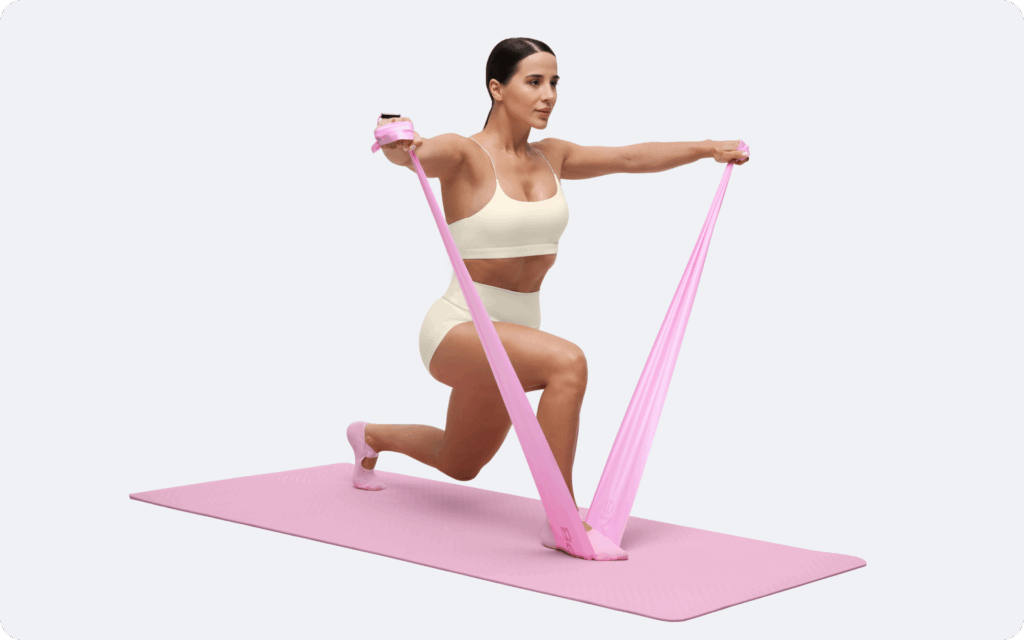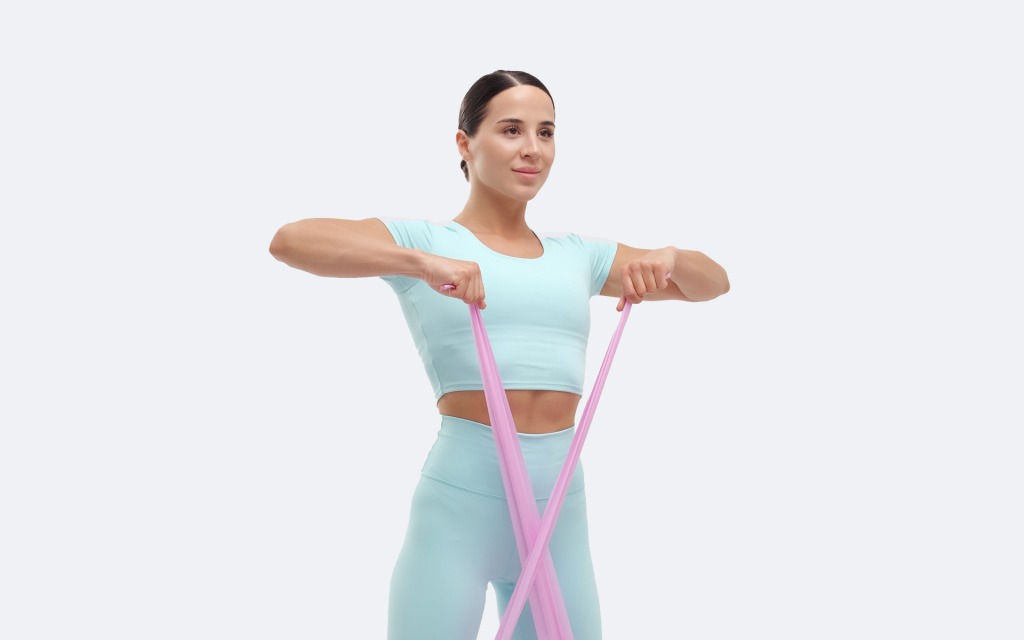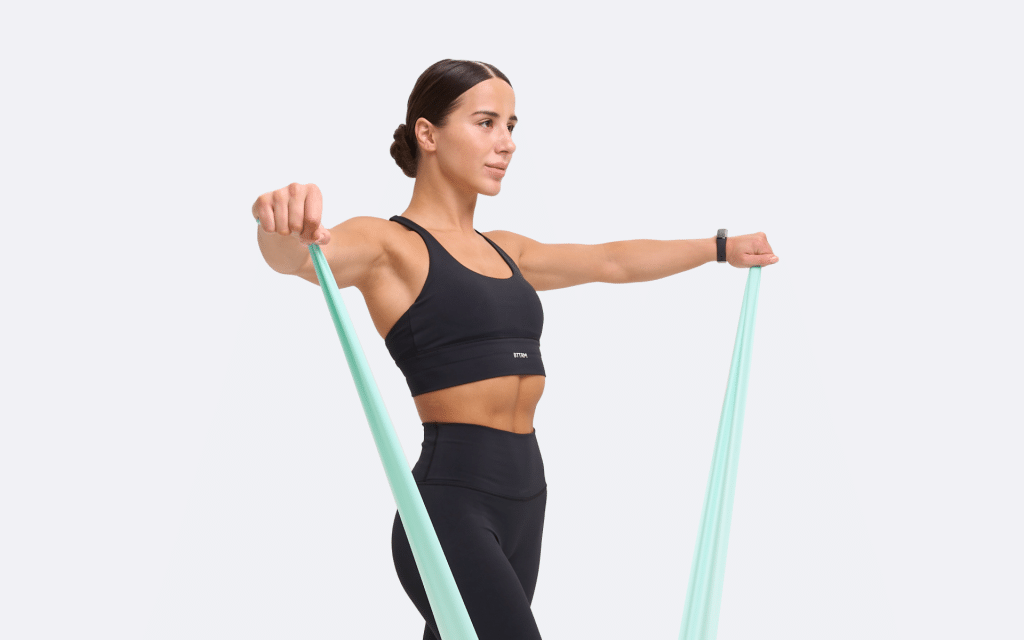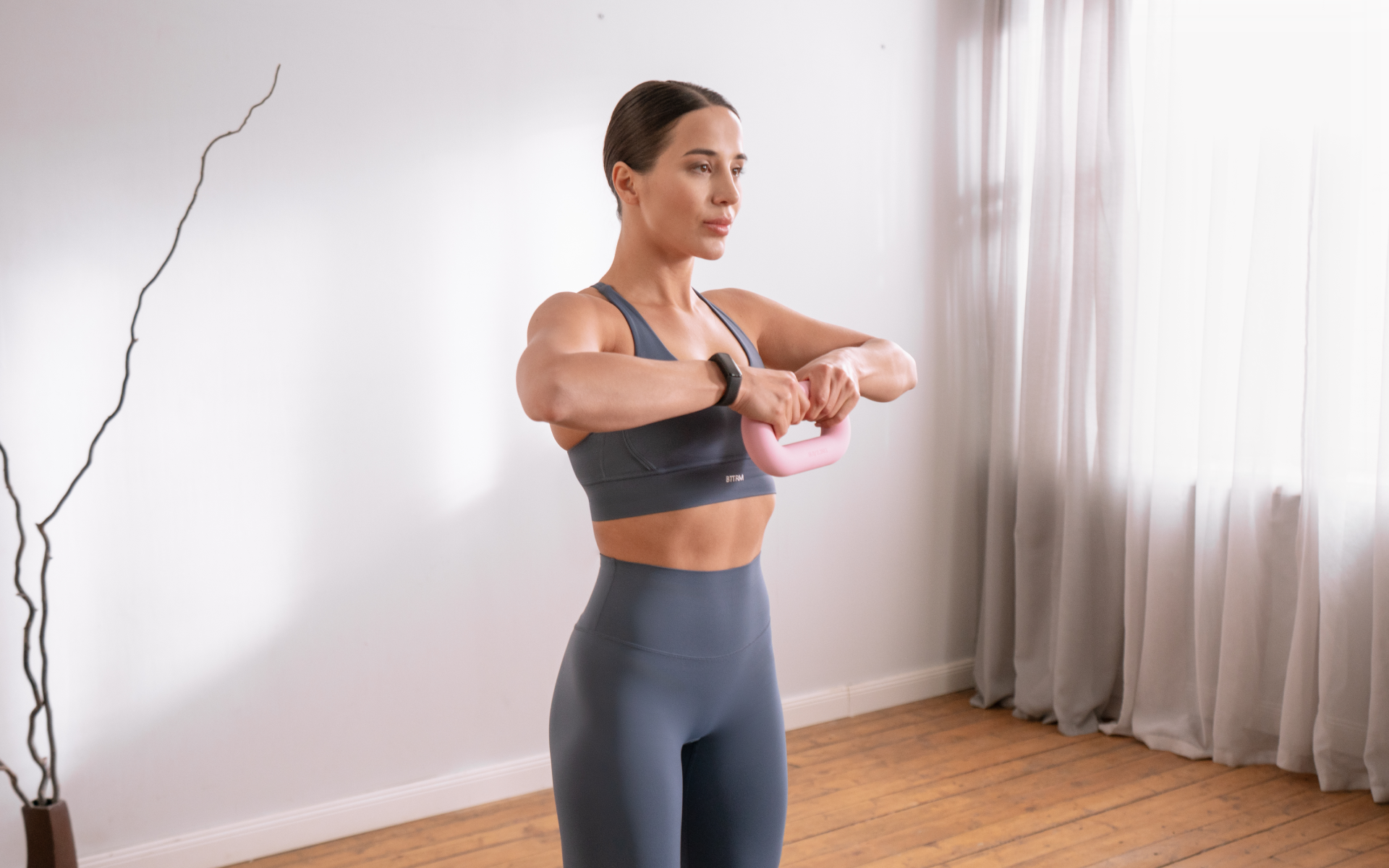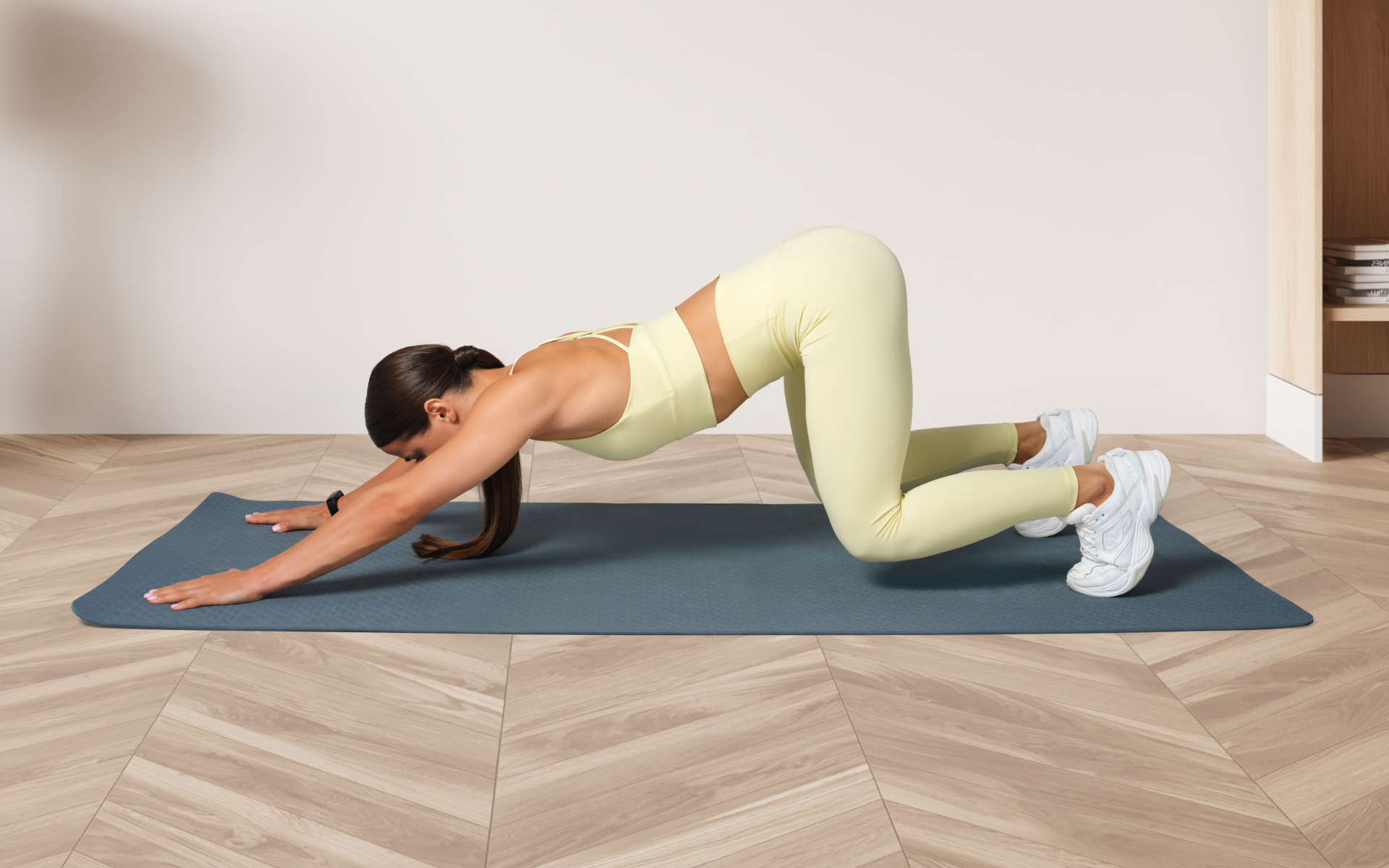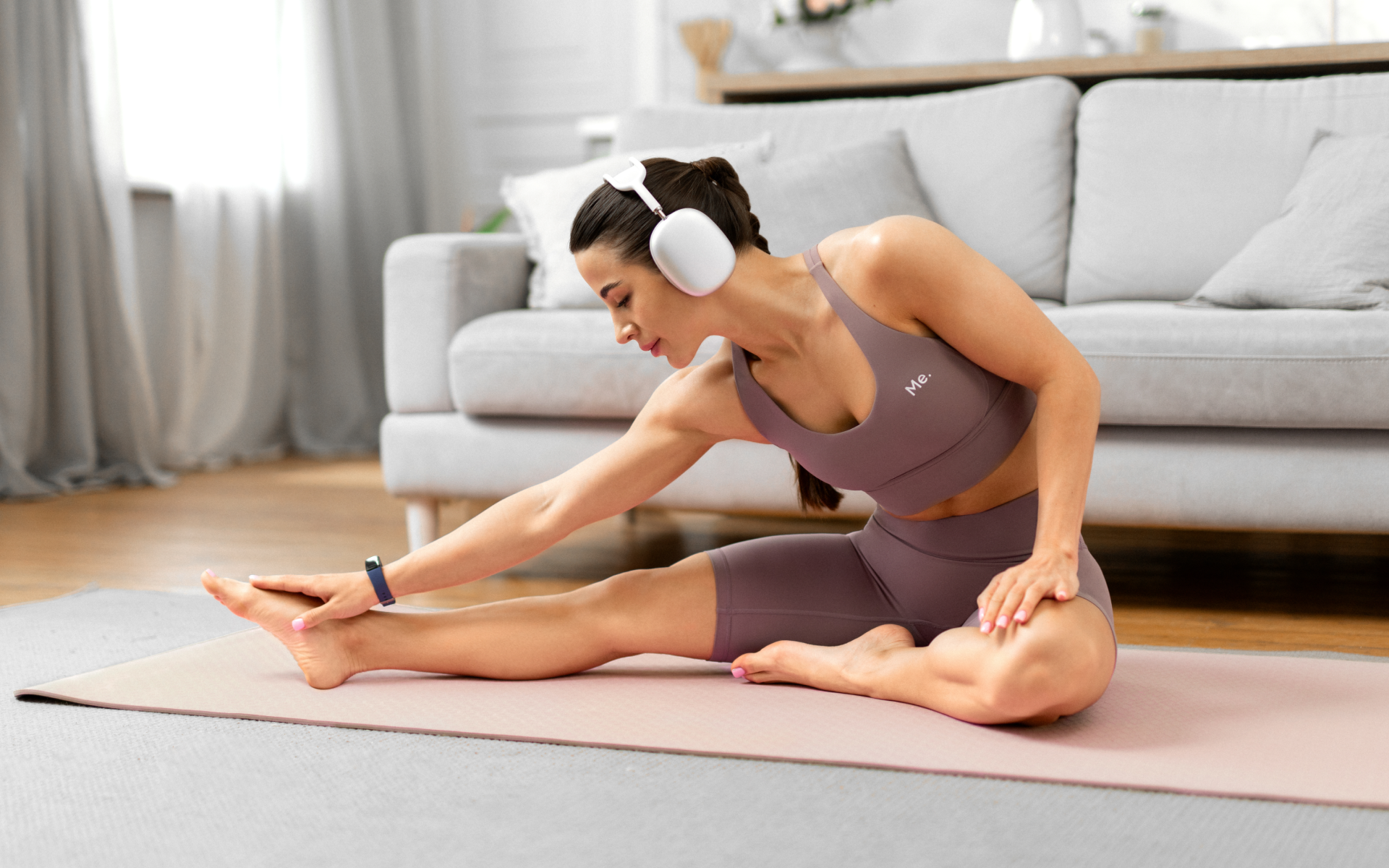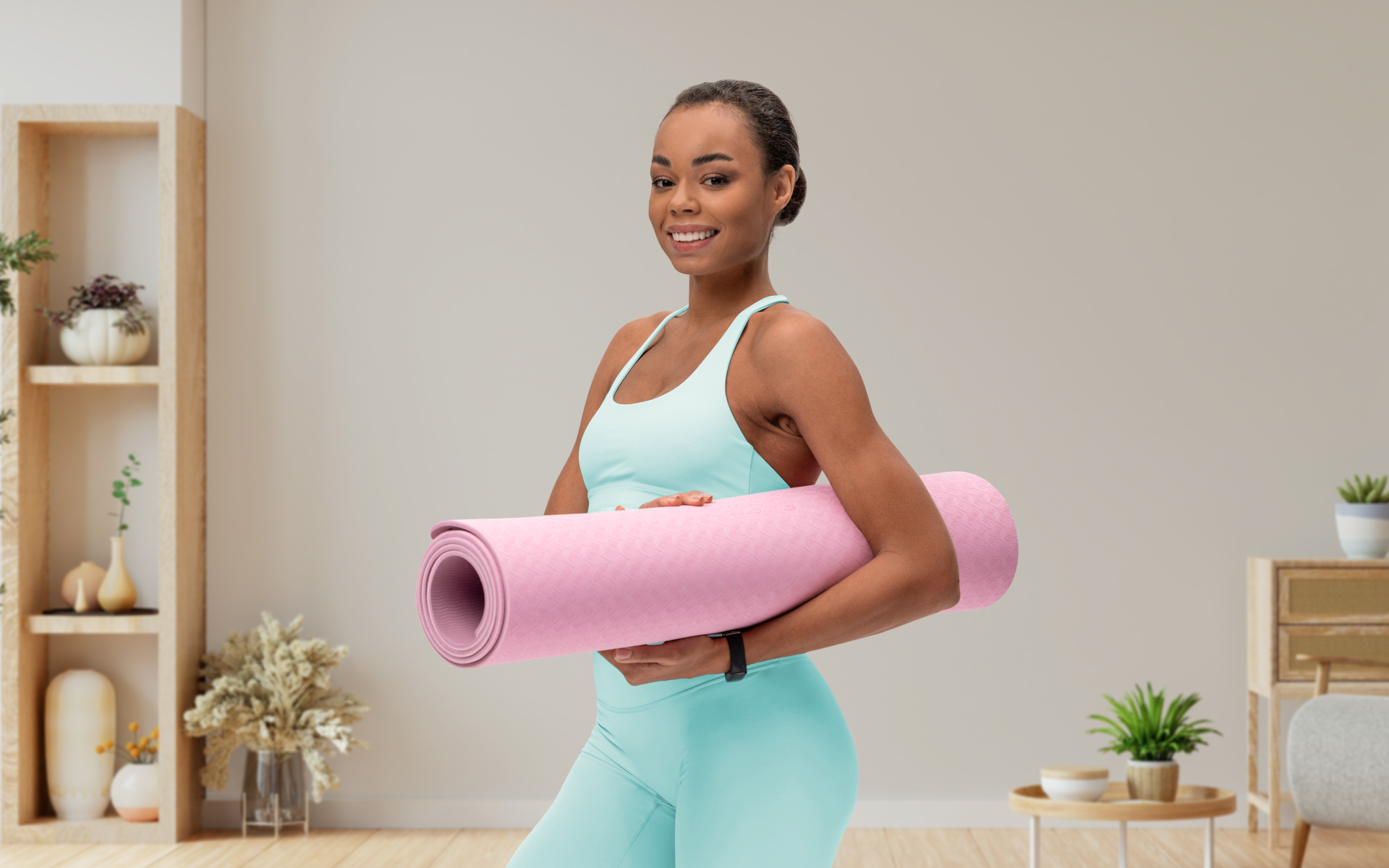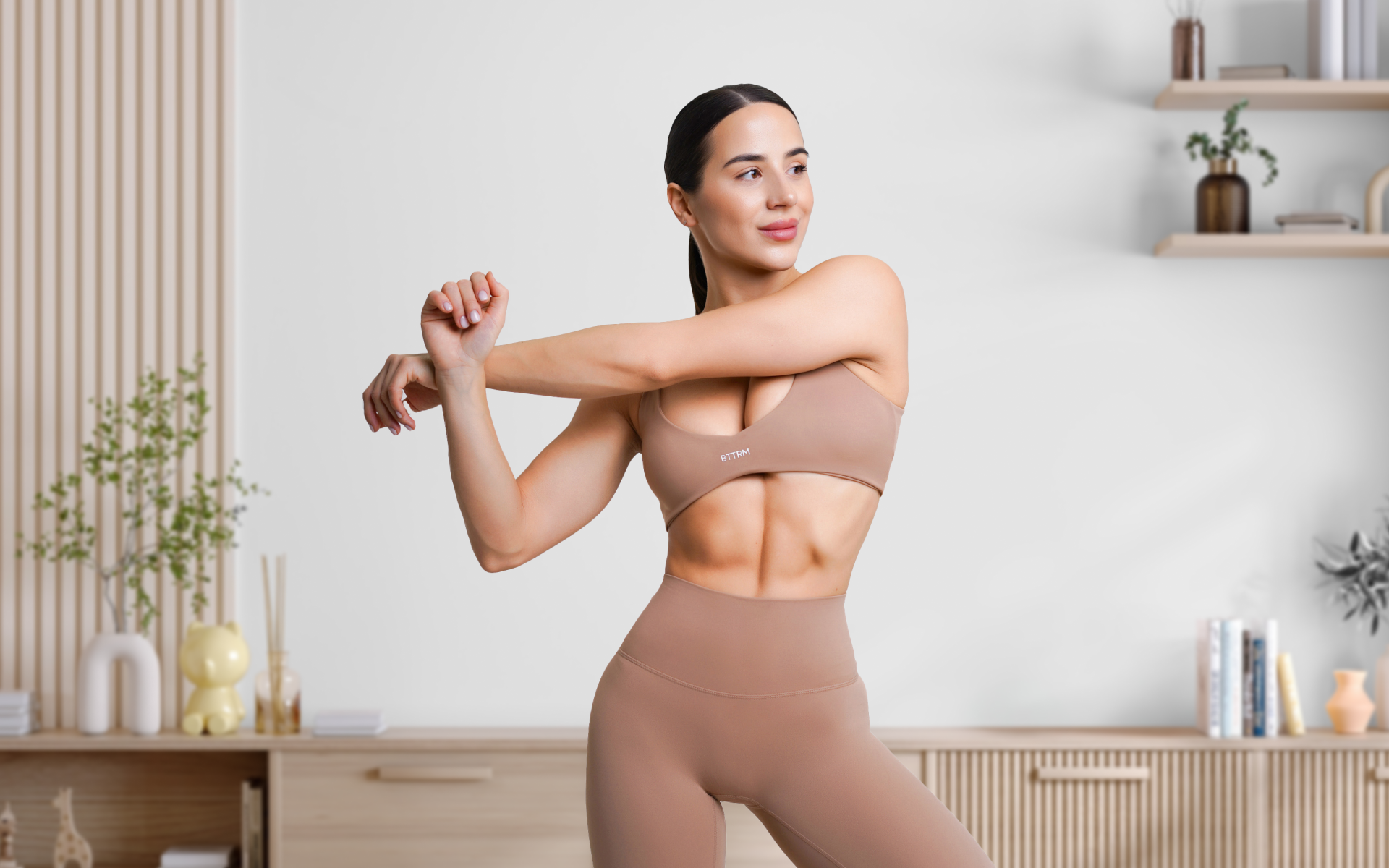There’s a quiet power in mat Pilates that sets it apart from other workouts. It’s not about flashy moves or heavy equipment, but about tuning into your body’s natural strength and range of motion. Every exercise is deliberate, challenging your core while encouraging control, precision, and flow.
Beginners may find Pilates an intimidating workout at first, particularly when there’s talk of “engaging your core” and “finding your neutral spine”. But fear not, with a Pilates weekly workout plan, you’ll be able to ease into the practice and reap its many benefits.
What Is a Good Weekly Workout Plan for Beginners?
This weekly Pilates routine is designed to target your entire body while improving your flexibility, strengthening your muscles, and enhancing your core stability.
The plan is balanced to give attention to different muscle groups each day, with warm-up stretches included before each workout. Equipment requirements are noted where necessary.
Weekly Plan Overview
- Monday: Warm-up + core strength
- Tuesday: Warm-up + arm and shoulder focus
- Wednesday: Warm-up + leg strength and stability
- Thursday: Full recovery (stretch and relaxation)
- Friday: Warm-up + full body power
- Saturday: Warm-up + back and posture
- Sunday: Active recovery (gentle core and stretching)
Equipment Needed for the Week:
- Optional weights
- Resistance bands
- Yoga or Pilates mat
Monday – Core Strength
Warm-Up
- Child’s Pose
- Start on your hands and knees.
- Sit back on your heels while stretching your arms forward on the mat.
- Relax your back and neck. Hold for 30 seconds to 1 minute.
- Hundreds with Legs in Tabletop
- Lie on your back with your knees bent at 90 degrees (tabletop position).
- Lift your head, neck, and shoulders off the floor.
- Straighten your arms so they hover off the mat by your sides, palms down.
- Pump your arms up and down as you exhale for five counts and inhale for five counts.
- Repeat 10 times (100 pumps in total). Optional Equipment: Add weights for extra challenge.
- Plank
- Lie face down, then lift your body onto your forearms and toes.
- Keep your body in a straight line, engaging your core.
- Hold for 20-60 seconds. Remember to breathe in through your chest and out through your stomach throughout this movement.
- Swan Prep
- Lie face down with your arms bent so your hands are under your shoulders.
- Engage your abs and lift your chest off the mat.
- Lower back down slowly.
- Repeat 10-12 times.
- Side Plank with Arm Extension
- Lie on your side and prop up on your forearm with your elbow under your shoulder.
- Straighten your body into a side plank, lifting your top arm straight up.
- Hold for 15-30 seconds per side.
Tuesday – Arm and Shoulder Focus
Warm-Up
- Shoulder Circles
- Stand tall and roll your shoulders forward for 10 repetitions.
- Reverse the direction and roll back for 10 repetitions.
- Dumb Waiter
- Sit or stand tall with your elbows bent at 90 degrees and your palms facing up.
- Pull your elbows slightly back, keeping them close to your body.
- Open your hands outward, then return to start.
- Repeat for 10-12 repetitions. Equipment Needed: Resistance band or light weights.
- Diagonal Arm Pulls with Circles
- Stand tall with your feet shoulder-width apart.
- Raise one arm diagonally across your body.
- Slowly trace small circles with that arm.
- Repeat 10 times, then switch arms.
- Kneeling Tricep Press
- Kneel on the mat with a long spine.
- Hold small weights in both hands (optional).
- Extend your arms straight back and then bend at the elbows.
- Repeat for 15-20 repetitions.
- Raised Arm Circles
- Extend both arms out to the sides at shoulder height.
- Make small circular motions forward for 10 repetitions, then reverse for 10.
Reasons why BetterMe is a safe bet: a wide range of calorie-blasting workouts, finger-licking recipes, 24/7 support, challenges that’ll keep you on your best game, and that just scratches the surface! Start using our app and watch the magic happen.
Wednesday – Leg Strength and Stability
Warm-Up
- Knee to Chest Stretch
- Lie on your back and bring one knee toward your chest.
- Hold for 30 seconds and switch sides.
- Bridge with Spine Articulation
- Lie on your back with your knees bent and your feet flat on the mat.
- Roll your spine up, lifting your hips one vertebra at a time.
- Slowly roll back down.
- Repeat 12-15 times.
- Side-Lying Leg Raise
- Lie on your side with your legs straight and stacked.
- Lift the top leg up to hip height, then lower slowly.
- Do 15 repetitions per side.
- Fire Hydrant
- Start on all fours.
- Lift one leg to the side while keeping the knee bent at 90 degrees.
- Lower it back down.
- Repeat 12-15 times per side.
- Curtsy Lunge
- Stand tall and step one leg diagonally behind you into a lunge position.
- Lower your body, keeping your chest upright.
- Push back to a standing position.
- Do 12-15 lunges on each leg.
Read more: Wall Lunges: The Exercise You Didn’t Know You Needed
Thursday – Stretch and Recovery
Warm-Up
- Forward Spine Stretch
- Sit tall with your legs extended straight and hip-width apart.
- Reach your arms forward while rounding your back.
- Hold for 15-30 seconds.
- Child’s Pose with Arm Stretch
- From child’s pose, walk your hands to one side to stretch your sides.
- Hold for 20 seconds, then switch to the other side.
- Supine Spinal Twist
- Lie on your back and extend your arms to the sides.
- Drop both knees to one side for a gentle twist.
- Hold for 20-30 seconds per side.
Friday – Full Body Power
Warm-Up
- Cat-Cow
- Start on your hands and knees.
- Arch your back upward (cat), then dip it downward (cow).
- Repeat 8-10 times.
- Plank Knee Drive to Leg Extension
- Start in a plank position.
- Bring one knee toward your chest, then extend it back.
- Repeat 10-12 times per leg.
- Mountain Climbers
- Start in a high plank position.
- Quickly alternate bringing each knee toward your chest.
- Continue for 30-60 seconds.
- Reverse Lunge with Arm Lift
- Step back into a lunge, raising both arms overhead.
- Return to standing.
- Repeat 10 per leg.
- Dynamic Kickbacks
- Start on all fours.
- Kick one leg straight back, then return to starting.
- Repeat 12 per leg.
Saturday – Back and Posture
Warm-Up
- Spinal Roll
- Stand tall and slowly roll down vertebra by vertebra.
- Roll back up to standing.
- Repeat 4-5 times.
- Seated Upper Back Rows
- Sit on the floor with your legs extended forward.
- Hold onto a resistance band looped around your feet.
- Pull the band toward your chest, then release.
- Repeat for 10-12 repetitions. Equipment: Resistance band required.
- Cleopatra with Arms to the Side
- Lie on your side with your knees bent.
- Lift your top arm and rotate your upper body open.
- Return to start.
- Perform 10 per side.
- Shave-the-Head
- Sit up tall with light weights in both hands (optional).
- Press the weights up and slightly back over your head.
- Lower and repeat 12-15 times.
- Bridge with Heel Lifts
- Perform a bridge position, keeping your feet flat.
- Lift both heels off the ground, then lower them.
- Repeat 15 times.
Sunday – Gentle Core and Stretching
Warm-Up
- Side-to-Side Child’s Pose
- Perform child’s pose, alternating between sides.
- Hold for 15 seconds per side.
- Side Stretch with Head Rotation
- Sit tall with your legs crossed.
- Place one hand on the mat and bend to the side, rotating your gaze toward the ceiling.
- Hold for 20 seconds, then switch sides.
- Mermaid Stretch
- Sit with both knees bent and to one side of the hip.
- Extend your top arm over your head, stretching your side.
- Repeat 10 times per side.
- Breathing
- Lie on your back with your hands on your abdomen.
- Focus on deep breaths, expanding your chest as you inhale and contracting your stomach as you exhale.
- Continue for 1-2 minutes.
Read more: At Home Pilates Equipment Guide For Beginners: Here’s What You Need To Start
How Often Should I Do Pilates to See Results?
To see measurable progress, a consistent practice of 2-4 sessions per week is ideal. This frequency allows enough stimulus for muscle adaptation while giving your body the recovery it needs to build strength and improve flexibility.
Beginners generally feel more aware of their bodies after just a few sessions, but tangible results such as increased core strength and better posture are typically evident within 4-6 weeks of regular practice (1). Keep in mind that consistency over time is more important than trying to overdo it immediately. Our previous post goes into great detail about the weekly workout plan at home.
Do I Need Rest Days from Pilates?
Yes, rest days are essential, even for Pilates. While Pilates is low-impact, it still challenges your muscles, particularly your core, stabilizers, and smaller muscle groups. As with any form of exercise, your body needs time to repair and strengthen muscles after they’ve been worked.
Overdoing it can lead to fatigue, which reduces the efficiency of your workouts. You should aim to include at least one or two rest or active recovery days (e.g. light walking or stretching) each week to avoid burnout (2).
Is It OK to Do Pilates Daily?
For most people, daily Pilates can be fine, but it depends on the intensity and variety of your sessions. Alternating between challenging workouts and more restorative, mobility-focused sessions is a smart way to practice Pilates every day without overloading your body.
For example, one day you may focus on strength and endurance exercises, while the next day you could prioritize stretching, alignment, or breathing work. This approach helps prevent overtraining and promotes balanced progress.
How Much Time Should You Spend on Pilates?
Pilates sessions can range from 20 minutes to an hour and the “right” amount of time will depend on your goals. Shorter sessions (20-30 minutes) are great for beginners, those with busy schedules, or as a supplement to other workouts.
Longer sessions (45-60 minutes) allow for a more comprehensive workout, integrating strength, flexibility, and mindfulness. Both approaches can be effective, as long as you’re consistent and fully engaged during the time you dedicate to Pilates. If you’re curious about the pilates workout routine, check out our earlier article.
When it comes to weight loss, progress is made by inches, not miles, so it’s much harder to track and a lot easier to give up. The BetterMe: Health Coaching app is your personal trainer, nutritionist, and support system all in one. Start using our app to stay on track and hold yourself accountable!
Is It Better to Do Pilates in the Morning or at Night?
There’s no universal “best” time for Pilates – it’s about finding what aligns with your schedule and energy levels. Practicing in the morning can be invigorating and help set a positive tone for the day by waking up your body and mind. On the other hand, evening sessions can help unwind tension after a busy day, promoting relaxation and better sleep.
Experiment with both to see when your body feels strongest and when Pilates fits best into your daily rhythm. Our previous post goes into great detail about bed Pilates for beginners.
Can Pilates Be Your Only Form of Exercise?
According to the World Health Organization (WHO), adults should aim for at least 150-300 minutes of moderate aerobic activity or 75-150 minutes of vigorous aerobic activity per week, together with muscle-strengthening activities on two or more days per week (3).
Pilates delivers excellent benefits in terms of core strength, flexibility, and overall muscle endurance (4), which makes it a fantastic choice for the muscle-strengthening portion of these guidelines. It’s particularly adept at targeting smaller stabilizing muscles and improving posture and movement efficiency.
However, traditional Pilates doesn’t provide the sustained cardiovascular demand that is required to meet the aerobic activity component of these recommendations.
While certain advanced or high-intensity Pilates classes may increase your heart rate, they typically fall short of what’s needed to improve cardiovascular health or endurance.
To ensure you’re covering all aspects of physical fitness, you may consider combining Pilates with activities that elevate your heart rate, such as brisk walking, cycling, swimming, or dancing. This approach helps balance your routine, addressing aerobic fitness while keeping the strength and mobility-enhancing benefits Pilates is known for.
If your primary goal is overall health, Pilates can serve as a core component of your fitness regimen, but it’s best to complement it with aerobic exercise in order to meet global physical activity guidelines.
This combination not only supports heart health, it also maximizes the efficiency of your workouts, ensuring you build strength, stamina, and a body that moves well in daily life.
Pilates isn’t a fat-burning activity in itself. It focuses on strengthening and toning muscles, particularly the core, which includes the abdominal area. However, in order to burn belly fat, you need to combine Pilates with a calorie deficit achieved through a balanced diet and cardiovascular exercises such as running, swimming, or cycling. It’s not necessary to do Pilates on an empty stomach, but it’s a good idea to avoid heavy meals beforehand. Light snacks such as fruit or yogurt 1-2 hours before a session can provide energy without causing discomfort. Listen to your body and find what timing and nutrition work best for your workouts. Pilates can be expensive due to the specialized equipment, the extensive training required for instructors, and the personalized attention that is often given in classes. Studios typically focus on delivering high-quality, small-group or one-on-one sessions, which increases costs compared to larger, generalized fitness classes. Neither Pilates nor the gym is universally “better” – it depends on your goals. Pilates is excellent for improving core strength, balance, flexibility, and overall body alignment. On the other hand, the gym may offer heavier strength training and cardiovascular equipment, which makes it better for building muscle mass or focusing on aerobic fitness. Many people find combining both complements their overall fitness routine.Frequently Asked Questions
Does Pilates burn belly fat?
Should I do Pilates on an empty stomach?
Why is Pilates so expensive?
Is Pilates better than the gym?
The Bottom Line
A Pilates weekly workout plan at home can be your ticket to better strength, flexibility, and overall well-being. By committing to a consistent schedule, pairing it with complementary exercises, and following expert guidelines, you can enhance your fitness while moving with greater ease and confidence.
DISCLAIMER:
This article is intended for general informational purposes only and does not serve to address individual circumstances. It is not a substitute for professional advice or help and should not be relied on for making any kind of decision-making. Any action taken as a direct or indirect result of the information in this article is entirely at your own risk and is your sole responsibility.
BetterMe, its content staff, and its medical advisors accept no responsibility for inaccuracies, errors, misstatements, inconsistencies, or omissions and specifically disclaim any liability, loss or risk, personal, professional or otherwise, which may be incurred as a consequence, directly or indirectly, of the use and/or application of any content.
You should always seek the advice of your physician or other qualified health provider with any questions you may have regarding a medical condition or your specific situation. Never disregard professional medical advice or delay seeking it because of BetterMe content. If you suspect or think you may have a medical emergency, call your doctor.
SOURCES:
- Adaptations to Endurance and Strength Training (2018, pmc.ncbi.nlm.nih.gov)
- Healthy Buffs: Making gains with your rest days (2018, colorado.edu)
- WHO Guidelines on Physical Activity and Sedentary Behaviour. (2020, ncbi.nlm.nih.gov)
- Pilates for improvement of muscle endurance, flexibility, balance, and posture (2010, pubmed.ncbi.nlm.nih.gov)
